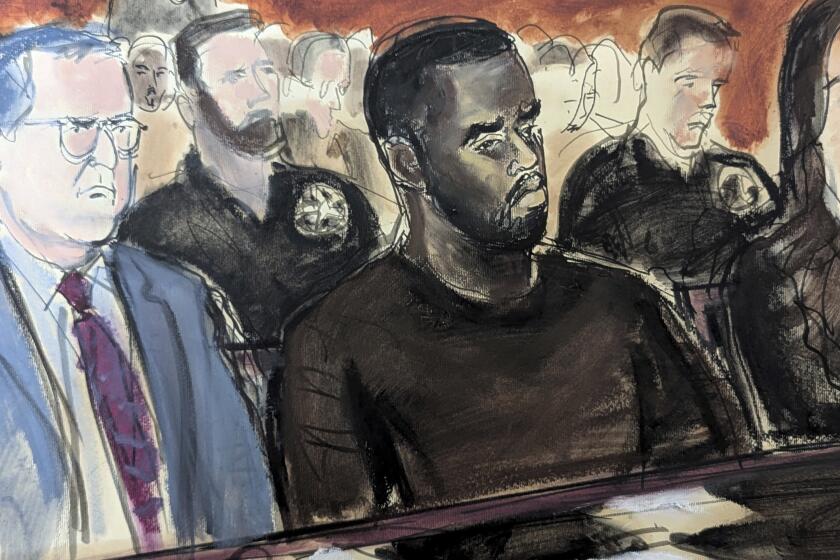A look inside Hollywood and the movies. : ON LOCATION: ‘SLIVER’ : Visualize Sharon Stone in ‘Basic Instinct.’ Now Imagine a Guy Sitting In That Chair
- Share via
In the 1980 hit “American Gigolo,” Richard Gere caused a sensation by shedding his Armani boy-toy clothes and lounging fully nude in front of a window.
The moment was notable because such male flashes of expression are so rare in Hollywood movies. In films produced by the studios, male screen nudity is, for the most part, taboo. Although some stars, like Mel Gibson, are happy to bear their bums, the majority refuse to play scenes of full frontal nudity.
“I don’t know of one studio head who would greenlight a film that called for male frontal nudity,” said one studio executive. “It’s a line that nobody wants to cross nowadays.”
Nobody, that is, except director Philip Noyce.
According to sources, the director’s current project, “Sliver,” is likely to include unprecedented amounts of on-screen male sexuality. Starring Sharon Stone and William Baldwin, the film opens Memorial Day weekend.
Unlike last year’s “Basic Instinct,” which dwelt almost exclusively on the feminine form, “Sliver” is an equal-opportunity revealer. According to sources, the rough assemblage of the movie contains considerable male frontal nudity, including several shots of Baldwin au naturel . One scene--which involves Baldwin and Stone writhing in front of a picture window--is said to be more sexually graphic than anything in “Basic Instinct.”
“Billy does things in this movie that most male stars would never dream of doing,” said one source. “Without question, it’s the sexiest leading-man role ever written for the screen.”
Noyce, the director of “Dead Calm” and “Patriot Games,” laughed when asked about the film’s male nudity. “I haven’t counted the shots, to be honest. I’m still cutting the film. But if you counted the square inches of flesh that are bared in the film, you could say that there are more male then female.”
“Sliver” couldn’t help but be provocative. A Joe Eszterhas adaptation of Ira Levin’s best-selling thriller, it’s described as a love triangle in a tall narrow New York apartment building (thus the title). The triangle participants: Stone and fellow tenants Baldwin and Tom Berenger.
One of Stone’s suitors has a secret: He has placed surveillance equipment in their apartments and spends a great deal of time spying on them. He learns about his neighbor’s bathroom habits, relationships and favorite sexual positions. According to one source, Noyce allows the surveillance cameras to linger on the private habits of both sexes and “doesn’t pull any punches or show any favoritism.”
“It’s a film about voyeurism,” says Noyce. “As a result, there’s a certain candor to the scenes which deal with sexuality, yes.
“I have never understood why in Hollywood male screen sexuality is taboo but female sexuality is not,” he says. “At its core it has something to do with the fact that men are in control: They’re controlling the images of themselves and of women. And that’s why we only see the women. Well, I didn’t want to do that.
“This is a woman’s story,” he adds. “Sharon, who moves into the building after fleeing an unhappy marriage, is the film’s lead character. And I was determined that it wouldn’t be another film on a long list of movies that exploited the female image.”
The exact number of frontal male nudity shots that will make it into the final cut of “Sliver” has yet to be determined.
One industry source wondered how the male nude scenes would sit with the MPAA’s ratings board, which is expected to review the film in the next couple of weeks. “You just can’t show full frontal male nudity in a studio picture anymore unless your lead actor is a statue,” said the source.
Noyce, who is said to be contractually bound to deliver an R-rated film to Paramount, calls the MPAA’s rating qualifications “hypocritical and a bit of a double standard.”
“The weird thing is that you can get an R with a shot of a fully nude female, but not a male, and I don’t think that’s right,” he says. “I think a film’s rating should be related to context, not form.”
That said, Noyce claims he would be open to making suggested MPAA trims depending “on how important the shots in question were to the dramatic integrity of the film. If certain shots in question could be cut without interfering with that, then I probably wouldn’t have a problem. But if they did, most certainly, I would fight.”
More to Read
The biggest entertainment stories
Get our big stories about Hollywood, film, television, music, arts, culture and more right in your inbox as soon as they publish.
You may occasionally receive promotional content from the Los Angeles Times.










